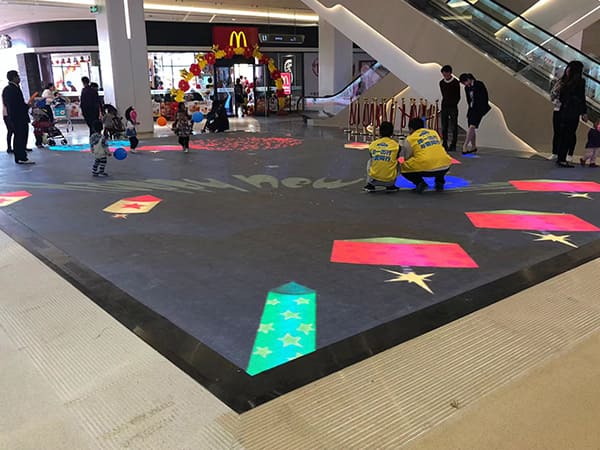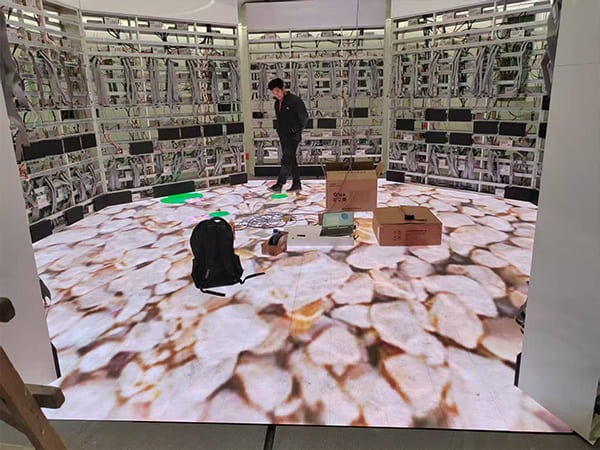Let's Find Out The Interactive LED Floor Tile Screen System Technical Principle
The LED floor tile screen system can offer human-screen interaction and show a tremendously beautiful visual effect by taking advantage of the integral operation of multiple advanced technologies backstage. Its technical principles consist mainly of display units, control systems, protection structures, and realization of interactive functions, etc.
Composition of interactive LED floor tile screens
1. In the signal capture section, capture and display are achieved in terms of interaction needs. The equipment for capture includes induction chips, video camcorders, cameras, etc. To achieve the sense of human-screen interaction, LED floor tile screens typically incorporate sensor technology. Common ones include pressure sensors, infrared sensors, capacitive sensors, etc. Let us consider the pressure sensor. When a pedestrian steps on the floor tile screen, the pressure sensor will sense the change in pressure and transmit the signal to the control system. Based on the preprogrammed program, the control system will initiate the corresponding changes in pictures, for instance, generating water wave diffusion, flower opening and other special effects. Infrared sensors can detect infrared radiation of the human body to calculate pedestrian position and movement and achieve dynamic response.
2. Signal processing part, which processes the real-time data gathered and maps generated data to virtual scene system; it mainly includes sending cards and receiving cards. The sending card translates and encodes the computer-generated images, video and other signals, and transmits them to the receiving card through network cables or optical fibers. The receiving card decodes the signal and drives the corresponding LED beads to display the corresponding picture. With video processing and other devices, input signals can also be scaled, spliced and other processed so as to accommodate floor tile screens of diverse resolutions and sizes, presenting high-definition and smooth images.
3. Interactive materials and floor tile display devices are used in the imaging section for displaying images at specified positions. LED floor tile screens can all be employed as interactive image display carriers.
4. Supporting equipment such as transmission lines, installation components, interactive main control, computers, engineering wiring, audio equipment, etc.
5. Protective structure: As LED floor tile screens need to be capable of withstanding external force such as pedestrians walking upon them and heavy vehicles running over them, the structural design and material selection are very cautious. Its surface is usually composed of high-strength and high-transparency tempered glass or polycarbonate (PC) materials with wear resistance, anti-slip and pressure resistance, and capable of supporting hundreds of kilograms of pressure. The internal circuit and LED beads are waterproof and dustproof, with a protection level usually reaching IP65 or higher, and can run normally in various indoor and outdoor environments.

Technical comparison of different systems
The interactive LED floor tile screen system applies a combination of virtual reality technology and motion capture technology, which is an extension of virtual reality technology. Virtual reality is an aspect of technology that employs computers to generate three-dimensional images to project a three-dimensional space and interact with it. With mixed reality, users are able to manipulate virtual images as well as touch the physical world and therefore make their sensory visual experience richer. The attributes of each system are as follows:
1. Practicality: The system can meet various actual and potential functional, environmental and other requirements, and achieve satisfactory results.
2. Reliability: The system can operate continuously over a long period of time and is stable and credible.
3. Advancedness: The functions and performance of the system have reached the advanced stage of display systems of the same category.
4. Sustainability: High-quality interactive main control purchase equipment is selected to ensure that the display effect of the system is stable for decades.
5. Convenience: It is easy to adjust and operate. The operating interface is tidy and the operating process is simple. It can be controlled and operated following a short training process.
6. Flexibility: The system can be reconfigured at hardware level with minimal interdependence of various devices. Some devices can be replaced at any given time as and when required without having to replace them all. The system can be expanded at any given time depending on demand fluctuations (by incorporating multiple sets of interactive materials) without compromising on the original resources.
7. Participation: The system can store a big number of people to have foot pedal interaction together at the same time, which is suitable for the characteristic of high foot flow. It is a hardware-equipped system, virtual simulation and image recognition technology. The work mode is that the LED ground tile screen records the foot and body gesture of the participants in the first place and sends the pictures to the interactive main control. After the intelligent processing of the system is integrated with the interactive material demonstration, virtual interactive images are generated. Finally, the process involves the participants and the interactive material images. It can be divided into various types depending on the usage context.

LED floor tile screens can be used often in new scenarios such as interactive exhibition halls, brand pop-up shops, and experience centers. Through the integration of sound, light, and electrical effects, they create spectacular visual interactive spaces, extending LED display application fields even wider.



